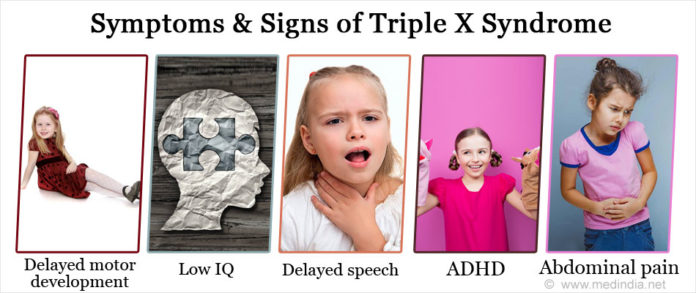Triple X syndrome — also called trisomy X or 47,XXX — is a genetic disorder in which a woman carries an extra X chromosome in each of her cells. Although it’s a genetic disorder, triple X syndrome (which only affects women) is almost never inherited.
People have 46 chromosomes in each cell, including one pair of sex chromosomes. Normally, women have two X chromosomes (XX) per cell, while men have one X and one Y chromosome (XY), according to the National Institutes of Health. (1) In women with triple X syndrome, a third X chromosome is present, which is why it’s referred to as 47,XXX.
Sometimes, only some of a woman’s cells have three X chromosomes, while the others will have the usual two X chromosomes. This is a form of triple X syndrome called mosaicism (or 46,XX/47,XXX), notes the National Organization for Rare Disorders. (2)
Causes and Risk Factors of Triple X Syndrome
Although triple X syndrome is a genetic disorder, it’s not usually an inherited one; rather, the condition is caused by a random error in the development of reproductive cells. (1)
In most cases, trisomy X occurs when the cells from the mother’s egg or the father’s sperm divide incorrectly, creating an egg or sperm that has an extra X chromosome. In women with mosaicism, the extra chromosome arises from an incorrect cell division that randomly occurs when the embryo (the fertilized egg) develops. The additional X chromosome usually comes from the mother.
The risk of these errors occurring may be associated with higher-than-average maternal age, according to the UK's Rare Chromosome Disorder Support Group. (4)
Duration of Triple X Syndrome
Triple X syndrome is a lifelong condition, but some of its symptoms — such as motor skill delays — appear earlier in childhood. Early intervention strategies, like speech therapy, physical therapy, and occupational therapy, can help some girls with trisomy X catch up to their peers or reach their full potential. (5)
Complications of Triple X Syndrome
Some women don’t have any symptoms of trisomy X, or only experience minor symptoms. Others will develop physical, behavioral, or emotional complications during adulthood or adolescence.
Some women with triple X syndrome can have premature ovarian failure, which can cause infertility issues or lead to early menopause. (5)
Related Conditions and Causes of Triple X Syndrome
Humans typically have 46 chromosomes (23 pairs) in each cell, including a pair of sex chromosomes. Females usually have two X chromosomes (XX) and males usually have one X and one Y chromosome (XY). (2) If a person has one or more additional sex chromosomes, they have a genetic condition called a sex chromosome aneuploidy (SCA).
People with one additional X or Y chromosome have a “trisomy” (“tri” means three). Trisomies are the most common sex chromosome aneuploidy, but there can also be “tetrasomies” (four sex chromosomes) or, rarely, “pentasomies” (five sex chromosomes).
Some of these conditions include:
- 47,XXY (Klinefelter syndrome): a chromosome condition in which a male carries an extra X chromosome. Males with the disorder can have infertility issues.
- 47,XYY (Jacob’s syndrome): a chromosome condition in which a male carries an extra Y chromosome. Males who have 47,XYY tend to be tall, but don’t tend to have infertility issues.
- 48,XXYY: a chromosome condition in males that results from having an extra X and Y chromosome.
- 48,XXXY: a chromosome condition in males that results from having two extra X chromosomes.
- 48,XXXX (tetrasomy X): a chromosome disorder in females that results from having an extra two X chromosomes.
- 49,XXXXY: a rare chromosome condition in males that results from having an extra three X chromosomes.
- 49,XXXXX (pentasomy X): a rare chromosome condition in females that results from having an extra three X chromosomes.
In general, people who have more chromosomes (such as those with tetrasomies and pentasomies) tend to have more pronounced symptoms than those with trisomies.
Resources We Love
Favorite Advocacy Organization
Association for X and Y Variations (AXYS)
The AXYS is an advocacy, education, and support organization for people and families of people who have Y and Y chromosome variations. It provides support to individuals with the conditions and experts who serve them, as well as champions research and treatment options.
Editorial Sources and Fact-Checking
- Triple X Syndrome. MedlinePlus. September 8, 2020.
- Trisomy X. National Organization for Rare Disorders. 2020.
- Tartaglia N, Howell S, Sutherland A, et al. A Review of Trisomy X (47,XXX). Orhanet Journal of Rare Diseases. 2010.
- Triple X Syndrome. RareChromo.org.
- Frequently Asked Questions. AXYS.
- Triple X Syndrome. KidsHealth.org. August 2017.
- Triple X Syndrome. Mayo Clinic. January 18, 2019.













































